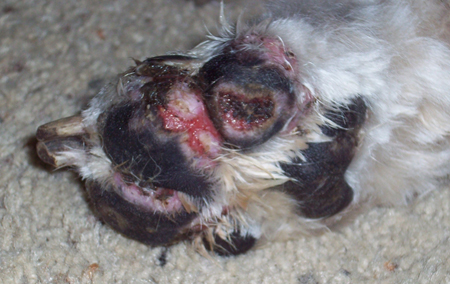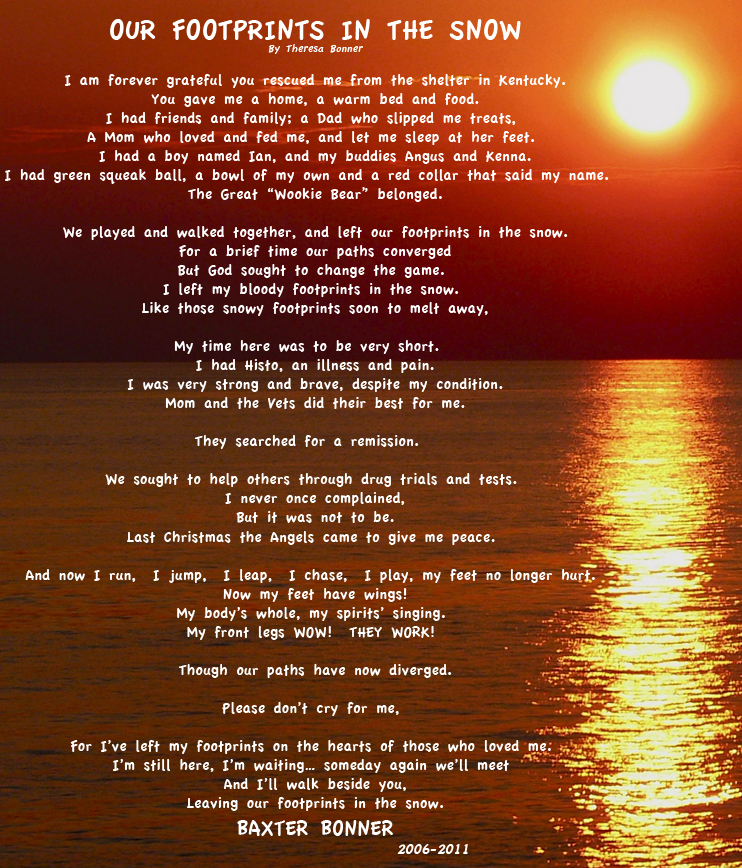
HOME
 YOUR HISTIO STORY
YOUR HISTIO STORY
I am looking for similarities
in all individual cases of
Histiocytic diseases.
I wonder if we all tell our
stories we might come up
with some commonality
between the specific
situations in which all of
our pets got this disease.
So please email me the
details and I'll put your
pets story on Shelley's
Histio Website
 UW HISTIO VERHAAL
UW HISTIO VERHAAL
Ik ben op zoek naar
overeenkomsten in alle
individuele gevallen van
Histiocytose.
Ik hoop dat wanneer wij
onze Histio verhalen
vertellen, wij overeen-
komsten ontdekken over
de manier waarop onze
huisdieren deze ziekte
hebben opgelopen.
Stuur mij de details en
ik zal het verhaal van uw
huisdier op de Histio
website van Shelley zetten.
 WARNING !
WARNING !
These stories are all
different. Individual
symptoms, situations
and circumstances
may vary and response to
therapy is not always the
same.
- Disclaimer -
 WAARSCHUWING !
WAARSCHUWING !
Deze verhalen zijn allemaal
verschillend. Individuele
symptomen, situaties en
omstandigheden kunnen
verschillen en de reactie
op therapie is niet altijd
hetzelfde.
- Disclaimer -
HISTIOCYTOSIS IN
OTHER LANGUAGES
German - Hund
Maligner Histiozytose
French - Chien
l'Histiocytose Maligne
Italian - Canis
Maligni Histiocytosis
Spanish - Perros
Histiocitosis Maligna
Dutch - Hond
Maligne Histiocytose
HOME
Baxter
*Possible* Systemic or Cutaneous Histiocytosis
Wheaten? or Old English Sheepdog? Mix
Male
Probably born in October 2006 / No definite diagnosis / died December 13, 2011


Baxter's story told by Theresa
Baxter is our beautiful Wheaten? or Old English Sheepdog? Mix. He was probably born in October of 2006. Baxter was abandoned along a highway in Kentucky in February of 2007. The Bell County Animal shelter picked him up cold, hungry and matted with a raging ear infection. The nearest they could figure is he was about 3 months old. They placed him in a great foster home. We found him on the petfinder website and had him shipped to my home in upstate New York. He was a beautiful pup with a quick ability to learn and a voracious appetite. He is very funny and well mannered. He gets along well with his Cairn brother and sister.
When Baxter was about 8 months old he would occasionally have bouts of wandering lameness. We tried agility a year later but the lameness persisted and we had to stop. The Vet took X-rays with no definite results. The winter of 2009-2010 he would occasionally leave blood spots on the floor which I attributed to ice or stepping on something. Then in July 2010 an observant groomer noticed pock marks or spots on Baxter's paws and suggested I take him to the vet. The pock marks were on all 4 paws. The vet wasn't sure what it was and gave him Simplicef. It seemed to get better but when the drugs stopped it progressed and now had a nodule on his left rear hock. It was September when the vet recommended a biopsy of his nodule and his paws. The report came back in early October. The vet called me at work with the results from the lab. She told me he had malignant histiocytosis. I was so devastated I had to leave work. We went to my vet later that afternoon for a chest x-ray which was negative.
I work in the medical field and began to search the internet for education and answers. Many of the descriptions of the disease fit but more of them didn't. Most importantly it was now the middle of October and my just 4 year old dog was still thriving and cancer wouldn't appear simultaneously on all 4 paws. He should have no longer been on this earth. You wouldn't know anything was wrong with him unless you looked at his foot pads. He was eating and everything else was normal. My vet got in touch with her professors at Cornell University who suggested I bring him in for a visit with the oncology department and dermatology. Maybe they could supply some answers.
I took Baxter to Cornell (3 hrs away) in early November. I was met by some very young eager professional vet students and a veterinary oncology resident who explained they would do ultrasounds of his abdomen, a bone marrow aspirate, more biopsies and blood work. When I left Cornell later that day I was informed that they believed that he may have reactive histiocytosis. There was a good chance he wasn't going to die. Baxter became the discussion at the end of that week at Cornell because his presentation was so unusual. The original lab diagnoses and the clinical presentation didn't match. While they hammered away at a definite diagnosis I was sent home with more Simplicef, tetracycline and niacinamide. I also added after some research fish oil, milk thistle, resveratrol and acidophilous. I received a call in early December that they were positive his disease was not cancerous. (I am so glad he doesn't have cancer but was this just as bad?) He was still doing well then, the ground was dry outside. Things were about to change.

Baxter's feet became infected when the snow began and kept coming and coming. They bled on everything, and finally became painful and swollen. We went back to Cornell in January and had more tests. Medications were upped and nothing happened. I covered his paws with booties that look like party balloons because they were reusable and I was able to sanitize them. Baxter had his check-up and a rabies shot. His feet seemed worse. We went back in March and they found the lymph nodes were now involved and his nodule on his hocks were larger. They now think he has systemic histiocytosis. They suggested a culture and sensitivity to be done at my vets office. The results came back with some very bad infections. They prescribed chloramphenical and baytril for the infections and pain meds. They also put him on prednisolone. I never saw an infection and swelling disappear so quickly. When he went for his next appointment on May 30th his feet were getting better.
In July his feet were healed but his legs were weak and shaky and his respiration was very fast. I took him to the vet for blood work. The blood work came back with 19k WBCs and some toxic neutrophils. The oncologist at Cornell wanted to see him. Back to Cornell we went. They agreed that the steroids were having an adverse effect but his feet looked completely healed. His nodules and lymph nodes had decreased in size. Maybe he only has the cutaneous form of the histiocytosis? He was taken off all antibiotics and his prednisolone was halved. Modified cyclosporine and ketaconazol was started. It would take several weeks to get the cyclosporine to a therapeutic level and my vet and I questioned the wisdom of decreasing the steroids so quickly. |Baxter's feet reacted almost immediately and within 3 days he had a new sore on his foot pad. I contacted my vet at Cornell and his prenisolone was increased but it is still less than it was initially.
It is now September 2nd, Baxter's sore on his foot has finally closed and he is not as weak as he was in mid July. He has a good quality of life. I was hoping to lower the steroids further but he now has lesions on his nose and the right side of his chest and abdomen. I called Cornell and we may be changing drugs. My vet has taken a cyclosporine level which was suggested by a vet at Cornell. The results came back yesterday and they are not at a therapeutic level. I am currently waiting for their suggestions. We're hanging in there for now. I am hopeful that we may find a drug that may put this disease to rest for a while.
I am thankful to my veterinary office and the vets, residents, students and staff at the Cornell University Companion Animal Hospital. A finer, more dedicated, humane staff would be hard to find else where. Baxter's case has been an excellent teaching tool for the vets and student vets at Cornell because it's uniqueness. I hope his treatment contributes to their understanding of this awful disease in pets and people.
I would like to say to anyone else facing a diagnosis of cutaneous or systemic histiocytosis, read everything you can and try to be informed. Be an active partner in your pets' treatment.
UPDATE December 13, 2011
I had to put Baxter down today. I am heartbroken....
Baxter's coat had changed. He lost his long hair and developed whitening spots in the gray parts of his coat. He turned 5 years old October first, his made-up birthday. Baxter developed front leg paralysis that had gotten progressively worse since early November. The vets were not sure what was going on. Some thought it was a slipped disc, others thought an infection, maybe it was the drugs and another said maybe cancer. The x-rays of his neck were negative and his blood work showed elevated liver enzymes, from the drugs? His labs weren't too far out of line. We had recently changed his meds from Cyclosporine to Leflunomide. He was circling and had no tolerance for the other dogs. His feet appeared stable and his lesions had shrunk. I hoped maybe it was a disc problem and it would resolve.
I came home from work on December 12th 2011 and found a pinkish and purple swelling on the inside of his right rear hock extending along the bone to his groin. I was devastated..... I knew it meant the end for him. I called the vet and she told me to come in in the morning. We gave him his pain meds.
December 13th 2011. We fed Baxter eggs for breakfast and more pain meds. My son went with me to carry the him. Baxter was whining uncontrollably in the office and my vet gave him a sedative and pain meds. The vet took blood work and x-rays of his leg. There were multiple calcifications in his soft tissues near his feet and his knee looked like something was eating it away. It was pathologically ready to break. His blood work was awful. We all cried alligator tears including my vet. My oncologist from Cornell was very upset. He had the x-rays reviewed by a radiologist. Our decision which I don't regret was to put him to sleep. He went very peacefully. It was the hardest thing I ever had to do..... I had him creamated. It is 12 weeks later and the first time I have written about him.
I still don't know what exactly happened. My guess is that maybe he really had histio-sarcoma with a very strange presentation. That the paralysis was caused by a tumor on his spinal cord. Did the treatments and nutritional supplements that we used for what we thought was cutaneous histiocytosis forestall the progression of histio-sarcoma? If that is true, then we did a very good job. He lived 17 months from the time we first noticed his disease and 15 months from diagnoses. He lived much longer than the average 104 days, dogs with his diagnosis live. It was only the last 5 weeks that weren't so good and not every day was bad. A couple of days before he died he was barking and leaping up in the air at the backdoor because he heard me put food in his bowl for breakfast.
My other dogs were lost without Baxter. They looked like they were waiting for him to return. I bought a new pup a month ago. He's a poodle and his name is Wylie. He's a handful and keeps me busy enough that I don't dwell on Baxter. It helps. There is no replacing him...... My dad who passed away last April always said he was going to steal my dog, ...........I think he got his wish.
I met the most caring professional people both at Nassau Vet Clinic and at Cornell University, and I am proud to call them friends. I want to thank them all. Donations were made to the Morris Foundation in Baxter's memory. I've received many condolence cards. I haven't spoken to Baxter's oncologist since he died. It's difficult to talk about Baxter without crying and don't know if I can intelligently get through a conversation but it needs to be done. One day at a time.


